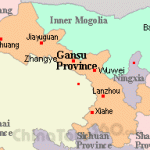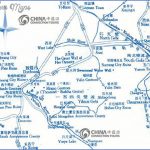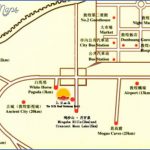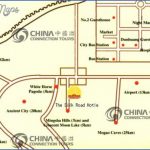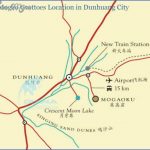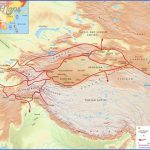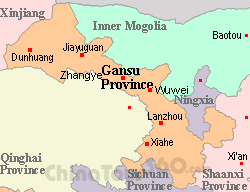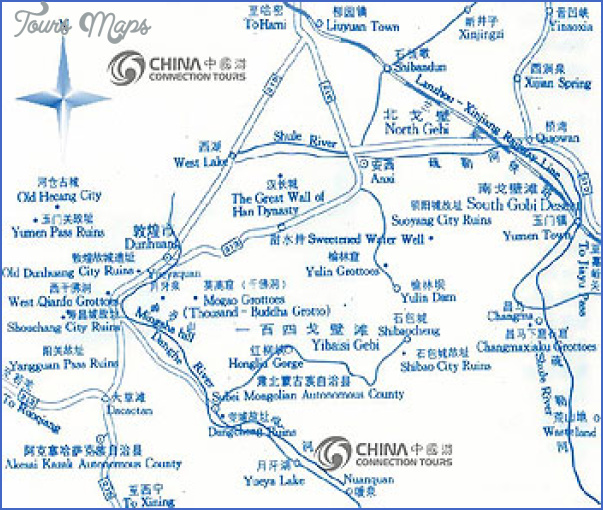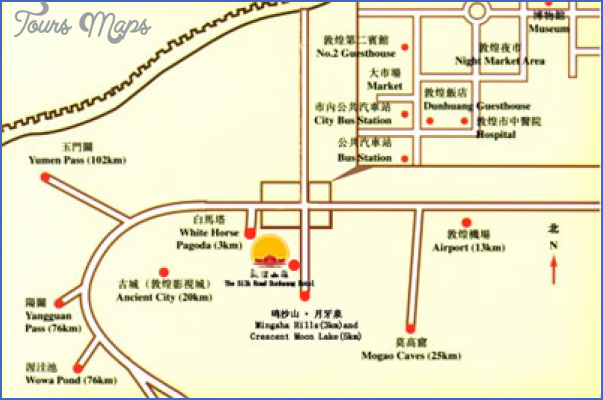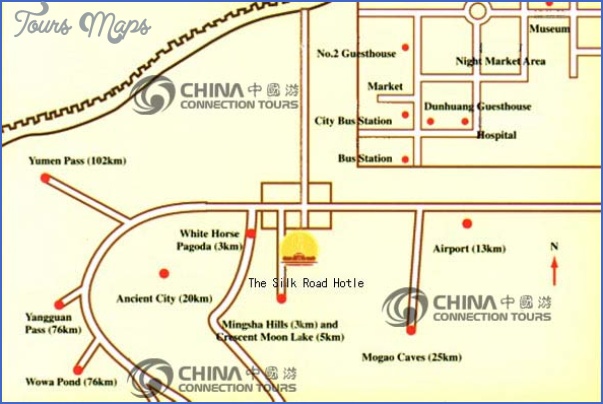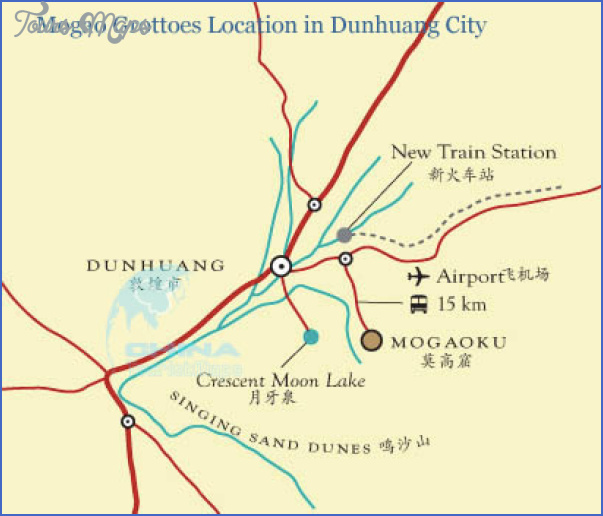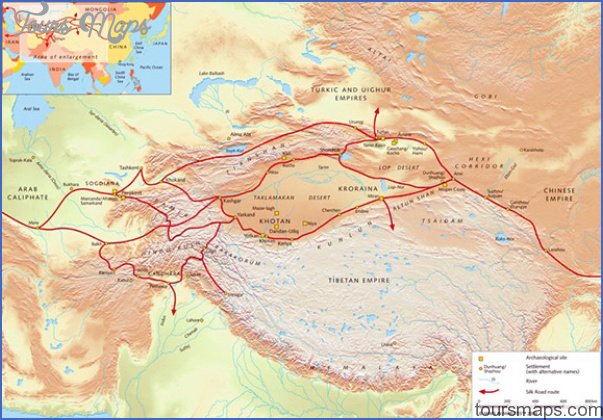Caves of the Northern Wei dynasty (386-534)
Dunhuang lies at 94°38’E and40°09’N in the west of Gansu province, on the famous Silk Road.
There are air flights from nearby towns and cities; buses run to Dunhuang from Liuyuan, which lies some 150km/93 miles to the north and is the nearest rail station on the Beijing-Urumqi line.
Under the rule of Emperor Han Wudi Dunhuang was elevated to the status of a town in 111 b.c. Its situation on the Silk Road, which divides here into two roads going north and south respectively, helped Dunhuang to enjoy an economic boom. Along this trade route new ideas, religious teachings such as Buddhism and scientific knowledge spread east and west. As a result Dunhuang has developed since the 4th c. to become a centre of Buddhism. In 619, when it was the seat ofthe administrative district ofthe same name, its name was changed to Shazhou; the remains of this old town lie to the west of present-day Dunhuang.
The main attraction for visitors to the area around Dunhuang are undoubtedly the unique treasures found in the Mogao Ku caves, also known as the Caves of the Thousand Buddhas (Qianfo Dong). Mogao is a small town 25km/15% miles south-east of Dunhuang. The caves are a very important centre of Buddhist art and give an insight into the political and economic life of the times during which they were constructed. The first grottoes were hewn out of the rock by monks in the year 366. As Buddhism spread so did the number of such caves, so that over a span of some 1000 years diggings were made into a wall of sandstone measuring 1600m/1 mile in length; by the Tang period (618-907) a thousand metres/eleven hundred yards had been excavated in this way. In the Ming period (1368-1644) the caves gradually became forgotten. It was not until the year 1900 that a monk named Wang Yuanlu found in Cave No. 16 60,000 valuable works of art which had probably been hidden there by monks in the 11th c. in order to safeguard them from their enemies. The find included books, documents, silk-paintings, embroidery and bronze statues dating from the 4th to the 14th c. The books – which embrace Buddhist, Taoist and Confucian writings as well as literary texts and philosophical and natural history treatises-are in various languages (Chinese, Tibetan, Sanskrit, Uigur, etc.) However, the authorities showed little interest in the finds, which were subsequently sold by Wang to British, French and Japanese collectors. It was not until 1949 that the Chinese government made efforts to preserve this unique cultural site and set up a research institute for this purpose. In 1987 UNESCO included the caves in their list ofthe World’s Cultural Heritage Sites.
492 mainly square or rectangular caves, with 2415 statues in coloured clay, 45,OOOsq.m/484,OOOsq.ft of wall-paintings and five wooden buildings have survived the ravages of time, but the remaining caves have been destroyed by the effects of weather. The largest grotto is 40m/130ft high and 30m/100ft wide and deep, while the smallest is less than 1m/3ft 4in. high. Each cave has a plaque showing its official number, date of construction and dynasty. The sculptures are all of painted clay, the largest being 33m/108ft and the smallest just 10cm/4in. They are of Buddhas, Bodhisattvas, holy men, youths and Buddhist believers. The wall-paintings cover all kinds of subjects – Buddhist characters, episodes from the Sutras, the teachings of Buddha, legends, fairy-tales, everyday scenes, floral patterns and geometric decoration.
The Wai Caves show unmistakable signs of Indian influence both in the choice of subjects and in the methods employed. The statues are of impressive size; the wall-paintings mainly portray scenes from the life of the historical Shakyamuni Buddha.
In Cave No, 254 the wall-paintings are based on a theme dear to the hearts of Buddhists – sacrificing self for the good of others. One picture shows Prince Sudana cutting flesh from his own body with a piece of dried bamboo cane in order to feed it to a hungry tiger lying next to him. The next scene shows his parents and siblings in mourning for the dead prince.
Cave No. 259 contains the statue of a Buddhist saint. Her white face and mysterious smile have earned her the nickname of “Mona Lisa”.
Cave No. 275, dating from the second half ofthe 4th cž is famous for its painting showing the self-sacrifices of Shakyamuni in an earlier life. Shakyamuni, then King Sivi, is sitting cross-legged and watching with satisfaction a dove which he has saved, while an executioner is cutting flesh from his body to feed an eagle, His serene countenance is in stark contrast to the grim face of the executioner. Other beautiful examples of the art of this period are Caves Nos. 248, 257, 260, 263, 272, 428,431,435 and 439.
On the walls of Cave No. 249, one ofthe caves ofthe Western Wei dynasty, Caves ofthe can be seen scenes of a tiger and antelope hunt; they show one hunter on Western Wei horsebackfollowing three gazelles and a second who has just killed a tiger, dynasty in particular the sculpture ofthe ascetic Mahakasyapa, who reflects the joy felt by one who has passed all the tests that life can impose. His decayed teeth, deeply-lined face and the protruding.veins in his neck all show how this ascetic suffered.
The wall-painting in Cave No. 423 shows the God ofthe East, an immortal being from Chinese mythology.
Note also Caves Nos. 244, 294, 295, 305, 404, 420 and 427.
The 213 preserved caves from the Tang period, where again a degree of Indian influence can be seen, make up the largest group. The largest Dunhuang statue, a 33m/108ft high Buddha Amitabha, will be found in Cave No. 96.
Cave No. 136 contains a 26m/85ft high figure, and No. 158 a reclining figure of Buddha as he enters Nirvana.
The wall-painting in Cave No. 220 shows a concert with musical instruments of the period – a valuable contribution to our knowledge of Chinese musical history.
In Cave No. 329 can be seen the famous wall-painting of “The Land of Buddha”, the Land of Purity. In the centre ofthe picture sits Amitabha on a throne of lotus blossom, with a Bodhisattva on each side. In front of him several young ladies are dancing and an orchestra is playing. Asparas, Buddhist angels, float between the clouds in the sky.
Also of interest are Caves Nos. 45, 112, 156, 217, 320-322, 328 and 445.
The persecution of Buddhists in 845 brought a stagnation of Buddhist art in its wake. As there was no space for any further caves to be builtthe existing ones were later restored. From that period 33 caves remain, and of these No. 16 is of particular interest. It contains a painting measuring 13-5m by 5m/44ft by 16ft ofthe Wutaishan Mountains and everyday scenes from this mountain region. It is a sort of map of the country, one of the oldest of its kind in China. Note also Cave No. 98.
During the Western Xia period little otherthan restoration work was carried out on the caves, while in the Yuan period nine new caves were constructed. Cave No. 465 is from this era and boasts 60 well-preserved frescos showing shepherds and craftsmen at work.
Other Sights
Mingshashan, 5km/3 miles south of Dunhuang, is 40km/25 miles long and 20km/121/2 miles wide. It was formed from quicksand. If someone slides down the hill it makes a whistling or ringing sound, from where it gets its name of the Ringing Mountain of Sand.
7km/41/2 miles south of Dunhuang lies this lake, which gets its name from its crescent-like shape. The formation of the lake resulted from a geological peculiarity-the north and south slopes are higherthan the east and west-and from the wind which blows from west to east. The wind initially blows in a south-easterly direction, is then forced upwards where it rotates spirally before finally retreating in an easterly direction. As a result, the lake has never once become silted up with sand in 1000 years.
30km/19 miles south-west of Dunhuang will be found the Western Caves of the 1000 Buddhas. These are of rather less importance. They contain paintings from the Northern Wei period (386-534), the Tang period (618 907) and the period ofthe Five Dynasties (907-960).
Dunhuang Map Photo Gallery
Maybe You Like Them Too
- The Best Cities To Visit in The World
- World’s 10 Best Places To Visit
- Coolest Countries in the World to Visit
- Travel to Santorini, Greece
- Map of Barbados – Holiday in Barbados

